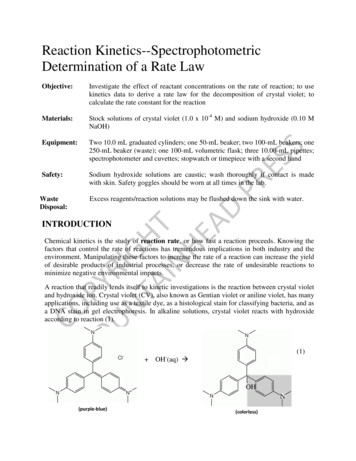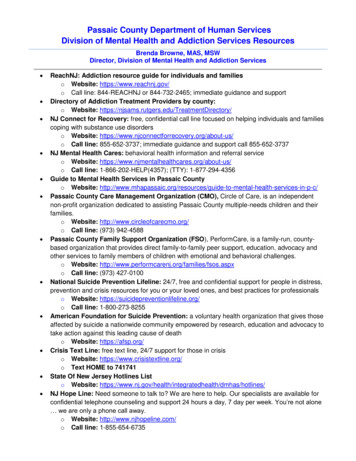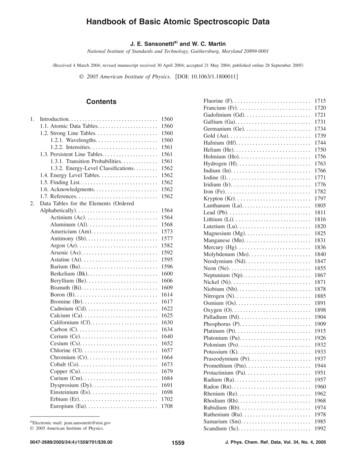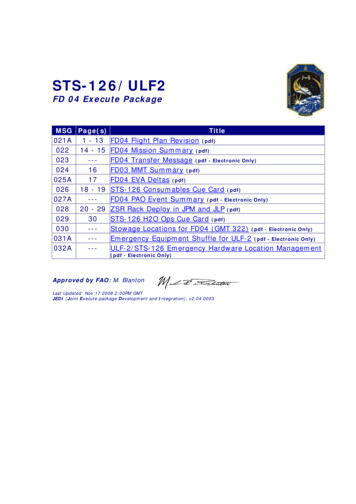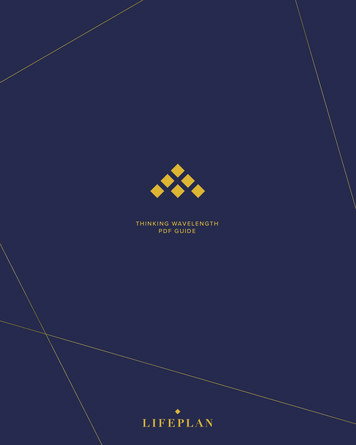
Transcription
T H I N K I N G WAV E L E N G T HPDF GUIDE
PHASE TWOSESSION6THINKINGWAV E L E N G T H
THINKINGWAVELENGTH3
PHASE TWOWATCH"THINKING WAVELENGTH"4Where do you make your greatest contribution?This tool is about how we’re hard-wired in our thinking.It’s about how we relate to change, risk, and opportunity.We have a hard-wired “high-contribution zone”, and there’s no right or wronghere. We can then measure this zone against where we are living today, whichhelps us to understand how aligned or disconnected we are to our sweet spot.In this video, you will hear Tom Paterson'sname mentioned. Tom is the founder ofthe Paterson Process.the Paterson Process to help you oryour organization gain perspective, lookahead and put a clear plan in place.Tom’s accomplishments prove hisprocess. To name just a few: he inventedthe PIN technology still used in ATM’stoday, collaborated with the Disneybrothers on Space Mountain, and workedwith the Reagan administration to openthe Chinese government to foreign trade.Peter Drucker called him the “greatestprocess thinker in the world.”Whether it’s StratOp - our proven systemfor organizations, or LifePlan - designedfor each unique individual; the PatersonProcess is crafted around insightfulquestions and accessible tools, to guideyou to clarity, breakthrough, and growth.Over time, Tom developed his uniqueapproach to strategy into a replicableprocess and passed his knowledge onto a new generation of strategic guides.Today, these certified Facilitators useToday, Tom lives in Fort Collins, CO.He remains focused, with all of us atPaterson, on passing on his processesto those gifted and passionate abouthelping individuals and organizationsdiscover and live their unique purpose.
THINKINGWAVELENGTHLife's too short tolive outside of your"sweet spot."5
PHASE TWO6WATCH"YOUR THINKING WAVELENGTH"It's time to discoverwhere you are on theThinking Wavelength
THINKINGWAVELENGTHTHINKING WAVELENGTHThis set of tools should take 45 minutesWATCH THE VIDEO AND ANSWER THESE SIX QUESTIONS WITH ANY NUMBER BETWEEN 1 & 10Don't answer what you think someone else wants you to answer.What we're seeking is truth about your sweet spot. Your honest assessment of yourself.There is not a right or wrong answer. A higher number is not better than a lower number.questionsspecificswhat is yourrelationship to1. Does not like risk. Immediate reaction is to resist.10. Embraces risk. Attitude toward risk is, “Let’s go!”what is yourrelationship to1. Does not like change.10. Thrives on change. Will create their ownchange if change isn't happening.RISK?CHANGE?how many VARIABLEScan you have in yourmind at one time?how do you thinkLOGICALLY?what is yourrelationship toAMBIGUITY?what is yourrelationship toOPPORTUNITY?1. Thrives with one or two variables.10. Comfortable with lots of variables.Note: this is not about multi-tasking. A variable isan idea or project in some stage of development.1. Walks step-by-step through a thought process,pausing often to ensure understanding.10. Can take quantum leaps in thought. The gaps willbe filled in later, or may not need to be filled in.1. Does not like ambiguity. Prefers concreteinformation before moving forward.10. Can live with a lot of ambiguity, without stress oranxiety. Assumes ambiguity will play itself out.1. Sees problems and tasks associated with anyexpressed opportunity.10. Sees opportunity everywhere. Yesterday’sopportunities are history.TOTAL: Add up your total from the right column, and DIVIDE BY 6. Write that numberhere. Then flip to the next page to plot your number on the Thinking Wavelength.1 – 107
PHASE TWOTHINKING WAVELENGTHPLOT YOUR NUMBER FROM THE PREVIOUS PAGEON THE THINKING WAVELENGTH BELOW.Draw a bell curve down from your number to identify YOUR SWEET SPOT(aka your "high-contribution VER8ADMINISTRATIVE/OPERATIONALRisk averseResists changeFew variablesOne step at a timeLow tolerance for ambiguityProblem/task orientedSEES/APPRECIATESBOTH SIDESSTRATEGIC/DEVELOPMENTALWelcomes riskEmbraces changeMany variablesQuantum leapsHigh tolerance for ambiguityOpportunity oriented
THINKINGWAVELENGTHREADGRINDERSFINDERSGrinders will do the same thing over and overagain, year after year—and love it. If you changethe way they do things, you’ll hear from them.The world cannot operate without grinders.They proudly grind it out, day after day.Follow-through is not always their strength.They need grinders, minders, and keepers tofollow in their wake of creativity. They senseand seize opportunities, spot voids and fillthem, are bored by a steady state, love a newchallenge, and must be thrown “raw meat”regularly.Grinders get the work done. They are detaildoers. Grinders document things, are riskaverse, like few variables, take things onestep at a time, have a low tolerance forambiguity, understand tasks and the needto solve problems, handle administrativedetails well, and deliver working drawings.MINDERSMinders can manage a unit team, having boththe people skills and the organizational abilitiesto do so. They can supervise the performanceof work. They function best as frontlinesupervisors, have the ability to diagnoseproblems, “mind the store,” and put out “fires.”They can run a department or program andmanage people.Minders are usually supervisors, teachers, chiefengineers, section leaders, program leaders,and foremen. They can be counted on to keepexisting processes and teams functioning andrunning well.KEEPERSKeepers are capable of managing the wholeorganization, possessing an appreciation forthe administrative and the strategic. Theyhave both concrete and abstract thinkingskills but will be biased to the administrative/operational work. They make great mediatorsin conflicts, good personnel managers,directors of departments or ministryprograms, plant managers, and executiveassistants. They handle details and see thebroader vision. They handle many variables,are organized, and good with people.Finders are abstract thinkers, so theyoftentimes don’t complete the paperwork thatconcrete thinkers require. They may appear tobe loose cannons in a group structure. Theyare innovators and creators.Finders are usually an entrepreneur, chiefexecutive officer, chief visionary, leader ofa product or market, joint venture leader, oradvanced development engineer. Finderswant to ensure their ideas work in the firstgeneration prototype—once they are assuredthat it does, they must hand it off to a keeperto build upon. Then they find something elseto develop.CONCEIVERSConceivers are usually bright, articulate andpersuasive, but they don’t bring things toclosure. They work best in universities andresearch laboratories. They cannot manageothers well, and their ideas rarely becomecommercialized. They may be criticized for“all talk and no follow through.” They embracerisks, can make quantum leaps, welcomechange, produce concepts, enjoy manyvariables, are opportunity-oriented, have ahigh tolerance for ambiguity, and love theforty-thousand-foot macro-view.Conceivers are theorists typically employedas researchers, philosophy professors,theologians, and innovators.9
PHASE TWO10You are who you are.Gaining clarity and truth aboutyourself helps to determinewhat needs to change.
THINKINGWAVELENGTHDiscovering where you are on the Thinking Wavelength is the first steptowards closing the gap between your sweet spot, and where you'recurrently living your life.SIGN UP FOR THE FULL LIFEPLAN ONLINE COURSETO CONTINUE YOUR JOURNEY.11
2017 The Paterson Center. All rights reserved. LifePlan, LifePlan OnDemand, and The Paterson Spiral, are trademarks ofThe Paterson Center, LLC, PO Box 270517, Fort Collins, CO 80527 USA. 303.578.9055 PatersonCenter.com V1-6.17
"THINKING WAVELENGTH" In this video, you will hear Tom Paterson's name mentioned. Tom is the founder of the Paterson Process. Tom’s accomplishments prove his process. To name just a few: he invented the PIN technolog




